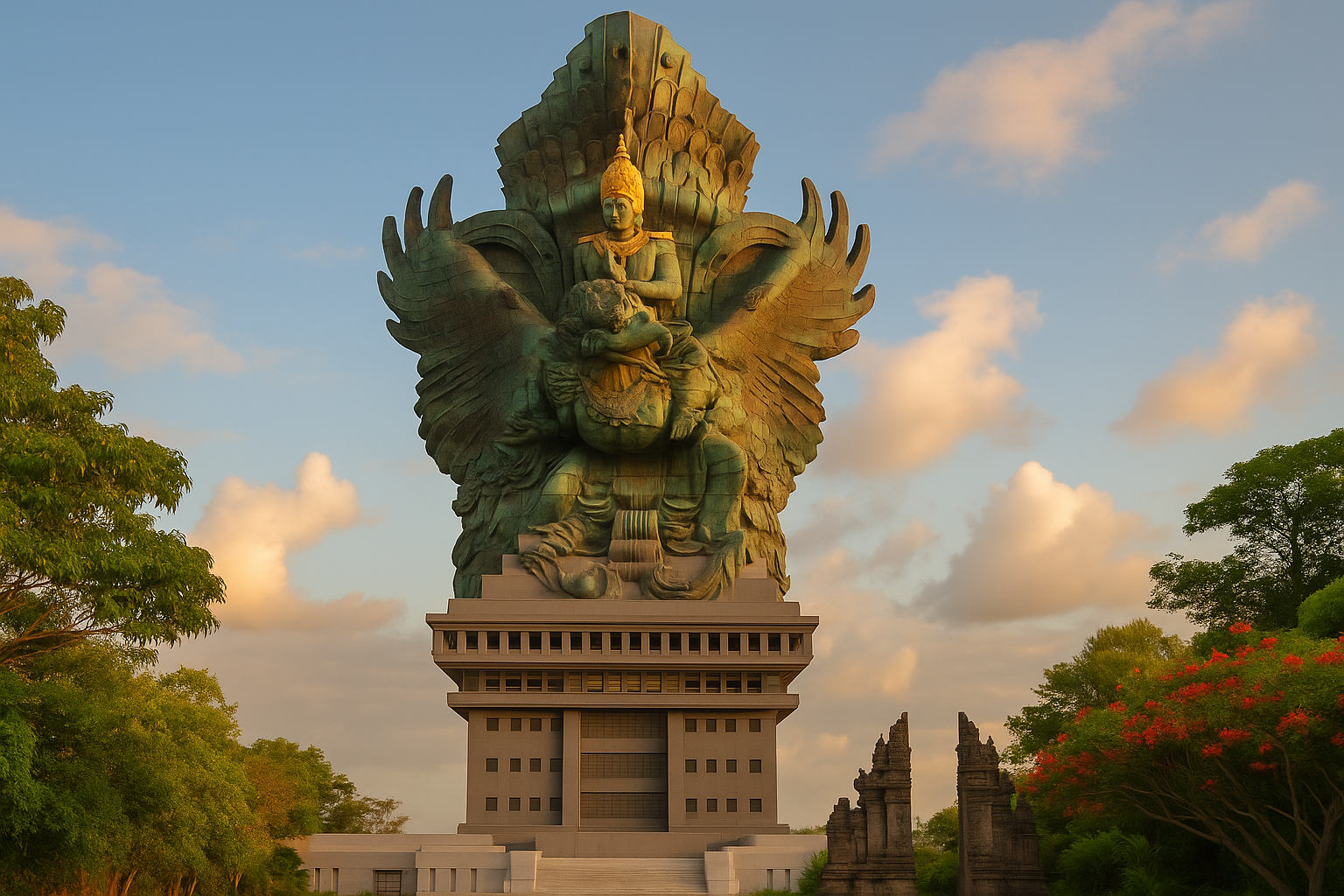Garuda Wisnu Kencana (GWK): A Majestic Cultural Icon in Southern Bali
Garuda Wisnu Kencana, commonly known as GWK, is one of Bali’s most iconic cultural destinations. Located in Ungasan Hill, Badung Regency, this cultural park offers an immersive experience combining art, history, and Bali’s natural beauty. GWK stands as a proud symbol of Indonesian culture and a must-visit destination for both local and international tourists.
History and Philosophy of GWK
The idea of GWK was initiated by renowned Indonesian sculptor I Nyoman Nuarta in the 1990s. The goal was to create a world-class cultural landmark that embodies the noble values of the Indonesian people, especially through the mythological story of the god Vishnu and his mount, Garuda. The story originates from Hindu mythology, where Garuda symbolizes devotion, courage, and strength.
Construction was halted due to the 1997 economic crisis but eventually resumed. The park was officially inaugurated on September 22, 2018, by President Joko Widodo. The statue’s construction took decades, making it one of the most ambitious art and architectural projects in Indonesia.
The Grandeur of the GWK Statue
The Garuda Wisnu Kencana statue stands at a total height of 121 meters (including its pedestal), making it one of the tallest statues in the world—even taller than the Statue of Liberty in the United States. It depicts Lord Vishnu riding Garuda, symbolizing protection over nature and humanity.
Made of copper and steel, the statue consists of 754 modules and weighs over 3,000 tons. Its construction and assembly required advanced engineering and technological expertise.
Attractions at GWK Cultural Park
Beyond the majestic statue, GWK Cultural Park offers a variety of cultural attractions and activities:
- Kecak Dance and Cultural Performances: Enjoy traditional Balinese dances, including the famous Kecak performance held at sunset.
- Lotus Pond: A large open area used for concerts, festivals, and major events like the 2022 G20 dinner.
- Plaza Wisnu and Plaza Garuda: Popular photo spots and the central hubs of the park.
- Museum and Art Galleries: Showcasing works from local artists and the statue’s creation process.
- Food and Souvenirs: A variety of restaurants and gift shops are available throughout the park.
Access and Admission
GWK is located about 15 minutes from Ngurah Rai International Airport. It is easily accessible by private car or online transport services. Ticket prices range from IDR 100,000 to IDR 125,000 for domestic tourists, with slightly higher rates for international visitors. The park is open daily from 9:00 AM to 9:00 PM (WITA).
Extend Your Stay: Villa Hasian Jimbaran
If you’re planning to explore more of southern Bali after visiting GWK, consider staying at Villa Hasian Jimbaran. Just a short drive from the cultural park, this elegant villa offers a tranquil escape with spacious rooms, a private pool, and panoramic views. Perfect for families, couples, or groups, Villa Hasian combines luxury and comfort while keeping you close to some of Bali’s most iconic destinations, including GWK, Uluwatu Temple, and Jimbaran Beach.
Whether you’re seeking relaxation or an ideal base to explore southern Bali, Villa Hasian Jimbaran offers the perfect blend of hospitality and convenience.
Frequently Asked Questions (FAQ) about Garuda Wisnu Kencana
1. What is Garuda Wisnu Kencana (GWK)?
GWK is a cultural park in Ungasan, Bali, featuring a giant statue of Lord Vishnu riding Garuda. It is a symbol of Indonesian culture and national pride.
2. Who created the GWK statue?
The statue was designed by renowned Balinese artist I Nyoman Nuarta.
3. How tall is the GWK statue?
The total height is 121 meters, making it one of the tallest statues in the world.
4. How much is the entrance fee to GWK?
Entrance fees for domestic tourists range from IDR 100,000 to IDR 125,000. International tourists pay slightly more.
5. What attractions can visitors enjoy at GWK?
Visitors can enjoy traditional dance performances, art galleries, museums, dining areas, souvenir shops, and the Kecak dance at sunset.
6. When is the best time to visit GWK?
The best time to visit is in the late afternoon, just before the Kecak dance performance at sunset.
7. Is GWK family-friendly?
Yes, GWK offers educational and cultural experiences suitable for visitors of all ages.
8. How do I get to GWK?
GWK is about a 15-minute drive from Ngurah Rai Airport and is accessible by private car, taxi, or ride-hailing services.
9. Are guided tours available at GWK?
Yes, guided tours are available to help visitors understand the history and philosophy behind the statue and cultural park.
10. Are there facilities for people with disabilities?
Yes, GWK provides accessible paths, lifts, and special toilets for people with disabilities.
Conclusion
Garuda Wisnu Kencana is not just a tourist attraction but a cultural heritage site that embodies Indonesia’s artistic and spiritual legacy. Its towering statue, profound philosophy, and diverse cultural offerings make GWK an everlasting icon. When visiting Bali, make sure to witness the grandeur of GWK and immerse yourself in the epic story it represents.






